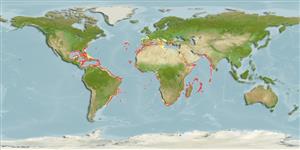Environment: milieu / Zona climática / intervalo de profundidade / distribution range
Ecologia
marinhas bentopelágico; intervalo de profundidade 100 - 770 m (Ref. 7412), usually 360 - 540 m (Ref. 7412). Deep-water
Eastern Atlantic: Azores, Madeira, the Canary Islands, Cape Verde and St. Helena Islands. Western Atlantic: West Indies, Saba Bank, Leeward Islands, off northern coast of Cuba and west of the Bahamas. Reported to occur in the northern coast of South America (Ref. 5217).
Comprimento de primeira maturação / Tamanho / Peso / Idade
Maturidade: Lm 26.0, range 20 - ? cm
Max length : 48.0 cm TL macho/indeterminado; (Ref. 5217); common length : 30.0 cm TL macho/indeterminado; (Ref. 7412); idade máx. registrada: 14 anos (Ref. 88061)
Espinhos dorsais (total) : 5; Raios dorsais (total) : 34 - 37; Espinhos anais: 4; Raios anais : 15 - 16; Vértebras: 29. Dark brownish grey in color, silvery below; black blotch on distal part of anterior dorsal rays (Ref. 6624). Snout blunt, rounded, adipose. Hyoid barbels present (Ref. 37108).
Body shape (shape guide): fusiform / normal.
Found on semi-hard and soft bottoms on the continental shelf and slope. Marketed fresh and frozen.
Ciclo de vida ou comportamento de acasalamento
Maturidade | Reprodução | Desova | Ovos | Fecundidade | Larvas
Hureau, J.-C., 1990. Polymixiidae. p. 625. In J.C. Quero, J.C. Hureau, C. Karrer, A. Post and L. Saldanha (eds.) Check-list of the fishes of the eastern tropical Atlantic (CLOFETA). JNICT, Lisbon; SEI, Paris; and UNESCO, Paris. Vol. 2. (Ref. 7412)
Status na Lista Vermelha da UICN (Ref. 130435: Version 2025-1)
Ameaça para os humanos
Harmless
Uso pelos humanos
Pescarias: pouco comercial
Ferramentas
Relatórios especiais
Baixar XML
Fontes da internet
Estimates based on models
Preferred temperature (Ref.
123201): 8.4 - 15.3, mean 11.4 °C (based on 187 cells).
Índice de diversidade filogenética (Ref.
82804): PD
50 = 0.5007 [Uniqueness, from 0.5 = low to 2.0 = high].
Bayesian length-weight: a=0.01202 (0.00911 - 0.01586), b=3.04 (2.96 - 3.12), in cm total length, based on LWR estimates for this species (Ref.
93245).
Nível Trófico (Ref.
69278): 4.2 ±0.73 se; based on food items.
Generation time: 5.1 ( na - na) years. Estimated as median ln(3)/K based on 2
growth studies.
Resiliência (Ref.
120179): médio(a), tempo mínimo de duplicação da população 1,4 - 4,4 anos (Assuming tm=2-4).
Fishing Vulnerability (Ref.
59153): Moderate to high vulnerability (48 of 100).
🛈
Nutrients (Ref.
124155): Calcium = 27.7 [17.0, 62.5] mg/100g; Iron = 0.479 [0.233, 0.908] mg/100g; Protein = 16.9 [15.8, 18.0] %; Omega3 = 0.322 [0.169, 0.635] g/100g; Selenium = 20.1 [8.9, 44.6] μg/100g; VitaminA = 16.4 [3.7, 73.8] μg/100g; Zinc = 0.337 [0.227, 0.497] mg/100g (wet weight);
